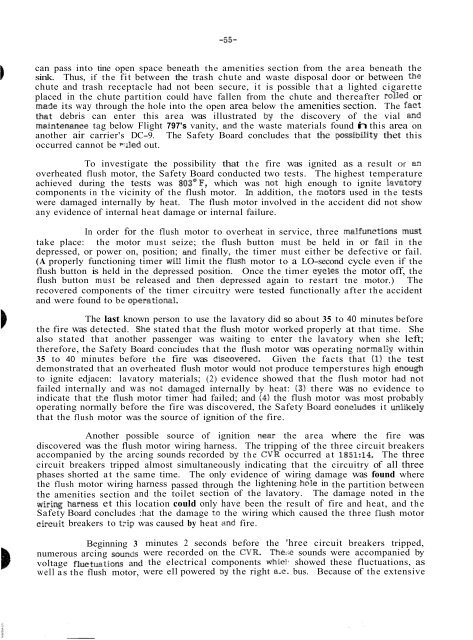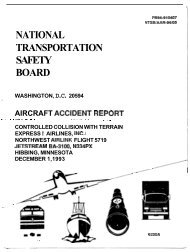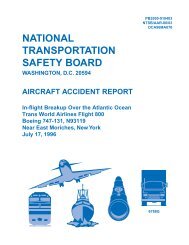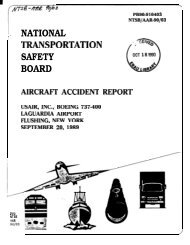NTSB/AAR-84-09 - AirDisaster.Com
NTSB/AAR-84-09 - AirDisaster.Com
NTSB/AAR-84-09 - AirDisaster.Com
Create successful ePaper yourself
Turn your PDF publications into a flip-book with our unique Google optimized e-Paper software.
can pass into tine open space beneath the amenities section from the area beneath the<br />
sink. Thus, if the fit between the trash chute and waste disposal door or between the<br />
chute and trash receptacle had not been secure, it is possible that a lighted cigarette<br />
placed in the chute partition could have fallen from the chute and thereafter rolled or<br />
maSe its way through the hole into the open area below the amenities section. The fact<br />
Lhat debris can enter this area was illustrated by the discovery of the vial and<br />
m8.intenance tag below Flight 797's vanity, w,d the waste materials found in this area on<br />
another air carrier's DC-9. The Safety Board concludes that the possihility thet this<br />
occurred cannot be p:iled out.<br />
To investigate the possibility that the fire was ignited as a result Of a?<br />
overheated flush motor, the Safety Board conducted two tests. The highest temperature<br />
achieved during the tests was 803OF, which was not high enough to ignite isvatory<br />
components in the vicinity of the flush motor. k addition, the izotors used in the tests<br />
were damaged internally by heat. The flush motor involved in the accident did not show<br />
any evidence of internal heat damage or internal failure.<br />
In order for the flush motor to overheat in service, three ma!functions must<br />
take place: the motor must seize; the flush button must be held in or fail in the<br />
depressed, or power on, position; ard finally, the timer must either be defective or fail.<br />
(A properly functioning timer will limit the flash motor to a LO-second cycle even if the<br />
flush button is held in the depressed position. Once the timer cycles the motor off, the<br />
flush button must be released and then depressed again to restart tne motor.) The<br />
recovered components of the timer circuitry were tested functionally after the accident<br />
and were found to be operationel.<br />
The last known person to use the lavatory did so about 35 to 40 minutes before<br />
the fire was detected. She stated that the flush motor worked properly at that time. She<br />
also stated that another passenger was waiting to enter the lavatory when she left;<br />
therefore, the Safety Board conciudes that the flush motor was operating normally within<br />
35 to 40 minutes before the fire was Ciscovered. Given the facts that (1) the test<br />
demonstrated that an overheated flush motor would not produce temperstures high enocgh<br />
to ignite edjacen: lavatory materials; (2) evidence showed that the flush motor had not<br />
failed internally and was not damaged internally by heat: (3) there was no evidence to<br />
indicate that tke flush motor timer had failed; and (4) the flush motor was most probably<br />
operating normally before the fire was discovered, the Safety Board cor,c!udes it uniiely<br />
that the flush motor was the source of ignition of the fire.<br />
Another possible source of ignition Fear the area where the fire was<br />
discovered was the flush motor wiring harness. The tripping of the three circuit breakers<br />
accompanied by the arcing sounds recorded by the CVR occurred at 1851:14. The three<br />
circuit breakers tripped almost simultaneously indicating that the circuitry of all three<br />
phases shorted at the same time. The only evidence of wiring damage was found where<br />
the flush motor wiring harness passed through the lightening hole in the partition between<br />
the amenities section and the toilet section of the lavatory. The damage noted in the<br />
wiring harnes et this location could only have been the result of fire and heat, and the<br />
Safety Board concludes :hat the damage ?o the wiring which caused the three &ash motor<br />
circllit breakers to Pip was caused by heat md fire.<br />
numerous arcing sounl;s were recorded on the CVR. The.:e sounds were accompanied by<br />
Beginning 3 minutes 2 seconds before the 'hree circuit breakers tripped,<br />
voltage fluctuetions and the electrical components whic!. showed these fluctuations, as<br />
well as the flush motor, were ell powered by the right LC. bus. Because of the extensive





